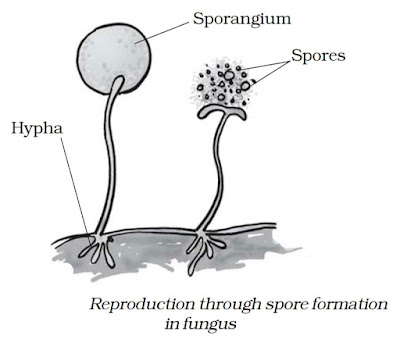Class 7 Science
Chapter- 12
Reproduction in Plants Notes
Reproduction- The production of new individuals from their parents is known as reproduction.
All organisms multiply or reproduce their own kind.
the reproductive parts of reproductive parts a plant. A flower may have either the male part or the female part or both male and female parts.
In plants there are two modes of reproduction, asexual and sexual.
Asexual reproduction- In asexual reproduction reproduction plants can give rise to new plants without seeds.
There are several methods of asexual reproduction such as fragmentation, budding, spore formation and vegetative propagation.
Sexual reproduction- In sexual reproduction new reproduction plants are obtained from seeds.
Sexual reproduction involves the fusion of male and female gametes.
Vegetative propagation- In vegetative propagation new plants are produced from different vegetative parts such as leaves, stems and roots.
MODES OF REPRODUCTION
Most plants have roots, stems and leaves. These are called the vegetative parts of a plants.
The flowers perform the function
of reproduction in plants. Flowers arethe reproductive parts of reproductive parts a plant. A flower may have either the male part or the female part or both male and female parts.
In plants there are two modes of reproduction, asexual and sexual.
Asexual reproduction- In asexual reproduction reproduction plants can give rise to new plants without seeds.
There are several methods of asexual reproduction such as fragmentation, budding, spore formation and vegetative propagation.
Sexual reproduction- In sexual reproduction new reproduction plants are obtained from seeds.
Sexual reproduction involves the fusion of male and female gametes.
Vegetative propagation- In vegetative propagation new plants are produced from different vegetative parts such as leaves, stems and roots.
Cutting- Cut a branch of rose or champa with a node. This piece of branch is termed a cutting.
Buds- Apart from flower buds, there are buds in the axil (point of attachment of the leaf at the node) of leaves which develop into shoots. These buds are called vegetative buds.
Eyes- Observe the scars on Fresh Potato.
You may find bud(s) in them. These scars
are also called “eyes”.
Budding is a type of asexual reproduction in which a new organism develops from an outgrowth or bud due to cell division at one particular site. The small bulb like projection coming out from the yeast cell is called a bud. The new organism remains attached as it grows, separating from the parent organism only when it is mature, leaving behind scar tissue. Since the reproduction is asexual, the newly created organism is a clone and is genetically identical to the parent organism.
Fragmentation -the process or state of breaking or being broken into fragments.
Spore Formation- Spore formation is a method of asexual reproduction which is found in non flowering plants such as fungi (Rhizopus) and bacteria. In this method of reproduction, the parent plant produces hundreds of tiny spores which can grow into new plants.
SEXUAL REPRODUCTION
The stamens are the male reproductive part stamens and the pistil is the female reproductive pistil part.
The flowers which contain either only the pistil or only the stamens are called unisexual flowers. The flowers which contain both stamens and pistil are called bisexual flowers.
A pistil consists male gametes of stigma, style and ovary. The ovary contains one or more ovules.
The female gamete female gamete or the female gamete egg is formed in egg an ovule.
In sexual reproduction a male and a female gamete fuse to form a zygote.
Pollination
The transfer of pollen from the anther to the stigma of a flower is called pollination.
If pollination the pollen lands
on the stigma of the same flower it is
called self-pollination.
When the pollen of a flower lands on the stigma of another flower of the same plant, or that of a different plant of the same kind, it is called cross-pollination.
Fertilisation-
The zygote process of fusion of male and female gametes (to form a zygote) is called
fertilisation.
The cell which results after fusion of fusion
the gametes is called a zygote.
The zygote develops into an embryo.
FRUITS AND SEED FORMATION
After fertilisation, the ovary grows into
a fruit and other parts of the flower fall
off. The fruit is the ripened ovary. The
seeds develop from the ovules. The seed
contains an embryo enclosed in a
protective seed coat.
SEED DISPERSAL
Seed dispersal is aided by wind, water and animals.
Seed dispersal helps the plants to
(i) prevent overcrowding,
(ii) avoid competition for sunlight, water and minerals and
(iii) invade new habitats












No comments:
Post a Comment